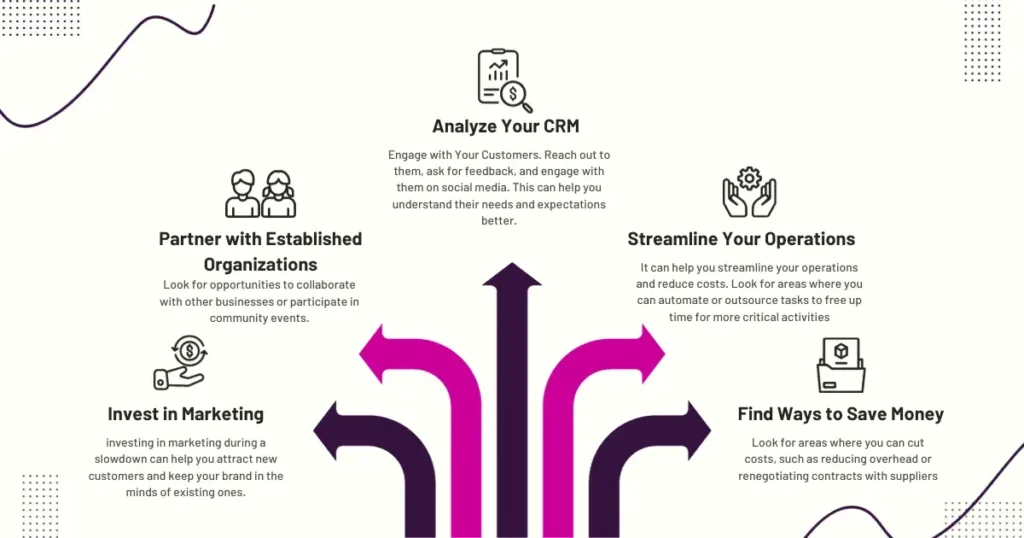As a young entrepreneur, it can be challenging to navigate slow business periods. However, it’s essential to address the issue promptly to avoid long-term negative effects on your business. In this article, we’ll explore some common reasons for slow business and provide strategies to improve your business during slow periods. Knowing what to do when business is slow and doing them early enough would help you bounce back stronger into the market.

Reasons for Slow Business
Before we dive into the strategies, it’s essential to understand the reasons for slow business. Here are some possible reasons:
- Cash flow problems
- Economic downturns
- Technology innovations and emerging competition
- Seasonal fluctuations
- Holidays
- Market movements
Slow business is when your business experiences a decline in sales or revenue. Various factors, such as economic downturns, seasonal fluctuations, or increased competition, can cause this. Slow business can be a temporary setback, but it can also have long-term consequences if not addressed promptly.
Strategies to Follow when Business is Slow
Here are some strategies to improve your business during slow periods:
1- Analyze Your Business:
Use this time to take a deep look into your business. Identify the areas that are performing well and those that need improvement. This could be in terms of products, services, operations, or even customer service.
2- Analyze Your CRM:
Analyzing your customer relationship management (CRM) system can help you identify areas for improvement. Look for patterns in customer behaviour, such as purchasing habits or communication preferences, and use this information to tailor your marketing and sales strategies. Engage with Your Customers. Reach out to them, ask for feedback, and engage with them on social media. This can help you understand their needs and expectations better.
3- Align Your Marketing and Sales:
Aligning your marketing and sales strategies can help you generate more leads and close more deals. Ensure that your marketing messages are consistent with your sales pitch, and use data to track the effectiveness of your campaigns.
4- Diversify Your Offerings:
If you’re seeing a consistent slowdown, it might be a good time to diversify your products or services. This can open up new revenue streams and attract new customers. Adding services or products that complement your existing business can help you generate more revenue from existing customers. Look for opportunities to expand your offerings and provide more value to your audience.
5- Focus on Upselling and/or Cross-Selling:
Upselling and cross-selling can help you increase revenue from existing customers. Identify complementary products or services that your customers may be interested in and offer them as part of a package deal.
6- Digital Transformation:
Invest in your online presence. Optimize your website, leverage SEO strategies, and explore e-commerce avenues to broaden your customer base. Embrace technology to improve operations. Whether it’s adopting new software or implementing digital solutions, staying tech-savvy is key.
7- Streamline Your Operations and Processes:
Refining your systems and processes can help you streamline your operations and reduce costs. Look for areas where you can automate or outsource tasks to free up time for more critical activities and reduce costs without compromising the quality of your products or services. This could involve negotiating with suppliers for better prices, reducing energy consumption, or improving processes to reduce waste.

8- Find Ways to Save Money:
Finding ways to save money can help you weather slow business periods. Look for areas where you can cut costs, such as reducing overhead or renegotiating contracts with suppliers.
9- Partner with Established Organizations in the Community;
Partnering with established organizations in the community can help you expand your reach and generate more leads. Look for opportunities to collaborate with other businesses or participate in community events.
10- Invest in Marketing and Revamp Your Marketing and Experiment:
Revamping your marketing and experimenting with new strategies can help you reach new audiences and generate more leads. Try new channels or tactics, such as influencer marketing or video content, and track the results to see what works best. A common reaction to a slowdown is to cut down on marketing expenses. However, investing in marketing during a slowdown can help you attract new customers and keep your brand in the minds of existing ones.
11- Step Up Your Social Media and SEO Game:
Stepping up your social media game can help you engage with your target audience and generate more leads. Use social media platforms to share valuable content, interact with followers, and promote your products and services. Optimizing your website for search engine optimization (SEO) can help you rank higher in search results and generate more traffic. Use keywords and meta descriptions to improve your visibility and ensure that your website is mobile-friendly.
12- Engage with Your Target Audience Through Email Marketing:
Engaging with your target audience through email marketing can help you build relationships and generate more leads. Use email campaigns to share valuable content, promote your products and services, and offer exclusive deals or discounts.
13- Host Pop-Up Sales and Events:
Hosting pop-up sales and events can help you generate more leads and create buzz around your business. Look for opportunities to participate in local markets or host your own events to showcase your products and services.
14- Tap into a Niche Market and Explore New markets:
Tapping into a niche market can help you differentiate yourself from competitors and generate more leads. Identify a specific audience or industry that you can serve well and tailor your offerings to their needs. But, If your current market is saturated or declining, it might be beneficial to explore new markets where your products or services could be in demand.
15- Create a Loyalty Program and Offer Promotions:
Creating a loyalty program can help you retain existing customers and generate more revenue. Offer exclusive deals or discounts to loyal customers and provide incentives for referrals or repeat business. If you’re seeing a consistent slowdown, it might be a good time to diversify your products or services. This can open up new revenue streams and attract new customers.
Mistakes to Avoid When Improving Business Processes
Here are some mistakes to avoid when improving your business processes:
- Not asking the right questions
- Fixing the wrong issues
- Not involving the right people
- Not having a clear process improvement plan
- Not measuring the right metrics
- Not following up on the process improvement plan
Understanding Slow Business Trends
Slow Times are an inevitable part of the business cycle. It’s essential to grasp when these occur, both in the retail and online world. Understanding the ebb and flow of business can help you make informed decisions.
Identifying Slow Business Trends
Understanding when businesses tend to slow down is the first step in addressing the issue effectively. Let’s explore the real data and trends:
The Slowest Retail Months
In the retail sector, some months consistently stand out as the slowest:
- January and February: Post-holiday season, consumers tighten their wallets, leading to reduced spending.
Best and Worst Months for Retail Sales
For retailers, it’s crucial to know when to expect the highs and lows:
- Best Months: The holiday season from November to December typically brings in the most revenue.
- Worst Months: As mentioned earlier, January and February are often the toughest.
Slow Months for Online Sales
Online businesses experience their fair share of slow months:
- February, March, and August: These months tend to see a decrease in online sales.
Remember, all businesses experience fluctuations in sales, revenue, and profit. A slow business is typically a period of low sales volume, where businesses are overstaffed, underworked, and aren’t meeting their revenue goal. This can happen due to various reasons, such as seasonality, slow business trends, and economic changes.
However, if your business is consistently underperforming across multiple areas (revenue, profitability, sales), it might be a sign of a failing business. In such cases, it’s crucial to seek advice from business professionals or mentors.
Real-Life Example
Here are two examples of successful businesses that overcame slow periods:
Apple Inc.: In one of the most famous business comeback stories of all time, Apple in 1997 was floundering after posting 12 consecutive years of financial losses1. However, with the return of Steve Jobs and the launch of innovative products like the iPod, iPhone, and iPad, Apple not only recovered but became one of the most valuable companies in the world.
Fujifilm: Until the late 1990s and early 2000s, Fujifilm was doing big business producing films for traditional cameras. As digital photography entered the mainstream, demand for camera film plunged. Fortunately, Fujifilm had already broadened its product base to include medical imaging, optical technology, and industrial products. Recognizing that the market was fundamentally shifting, the business divided its efforts between getting the best profits it could from the outgoing film market while gearing up its other operations and branching out into areas like graphical art supplies and equipment servicing. This diversification and pragmatic approach allowed Fujifilm to survive and thrive, while its US counterpart, Kodak, went out of business in 2012.
These examples show that businesses can overcome slow periods by innovating, diversifying, and adapting to market changes. It’s important to remember that every business faces challenges, but with the right strategies and mindset, these challenges can be turned into opportunities for growth and success.
The Path Forward
When business slows down, it’s not a time to despair but an opportunity to innovate and grow. These real solutions, grounded in data and experience, can help your business not only survive but thrive during challenging times.
Slowing sales can be a foreboding sign that a business is failing to retain customers and attract new ones. To keep a business running smoothly, a steady supply of both returning and new customers is a necessity. However, many entrepreneurs forget that balance is key. Focusing too much on acquiring new customers and getting the word out about the business can mean neglecting the customers that have been with them from the start of the journey.
In conclusion, a slow business can be challenging, but addressing the issue promptly is essential to avoid long-term adverse effects on your business. You can improve your business during slow periods by analyzing your CRM, aligning your marketing and sales, and focusing on upselling and cross-selling. Avoid common mistakes, such as not asking the right questions or fixing the wrong issues, and implement strategies, such as creating valuable content or hosting pop-up sales, to generate more leads and revenue.



